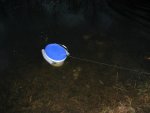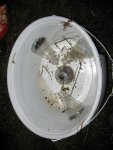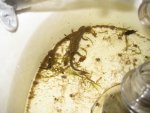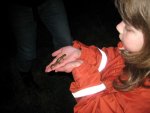The following pictures were taken during a field trip to newt breeding ponds, organized by the local chapter of NABU (German NGO) / Northern North-Rhine-Westphalia / Western Germany / March 2009.
The pictured traps were used to document breeding activity of the three newt species native to this area (which are aquatic only during spawning season with individual exceptions by Triturus cristatus) and, to some extent, to assess the breeding population of Triturus cristatus (capture-recapture-method by means of individual ventral patterns).
The traps were controlled daily and newts were released back into the ponds after documentation.
The floating trap is secured with a line in the pond. Note that the floating bodies on the sides of the trap are also very important to ensure sufficient airspace underneath the lid of the bucket. Trapped newts would drown without this possibility to breathe.

A view of the interior of the trap. The soda-bottlenecks function as funnels. The newt enters the bucket through the bottleneck, but is not able to leave the bucket again (similar to a trap for minnows or crawfish). Bottom and lid of the bucket are perforated to ensure a quick flooding when the trap is put in place in the water.

Triturus cristatus, Mesotriton alpestris and Lissotriton vulgaris were found in the traps. A nice M. alpestris-female in this case.

There was quite a crowd of children accompanying the grown-ups. Seemed like they all had a great time.

The pictured traps were used to document breeding activity of the three newt species native to this area (which are aquatic only during spawning season with individual exceptions by Triturus cristatus) and, to some extent, to assess the breeding population of Triturus cristatus (capture-recapture-method by means of individual ventral patterns).
The traps were controlled daily and newts were released back into the ponds after documentation.
The floating trap is secured with a line in the pond. Note that the floating bodies on the sides of the trap are also very important to ensure sufficient airspace underneath the lid of the bucket. Trapped newts would drown without this possibility to breathe.

A view of the interior of the trap. The soda-bottlenecks function as funnels. The newt enters the bucket through the bottleneck, but is not able to leave the bucket again (similar to a trap for minnows or crawfish). Bottom and lid of the bucket are perforated to ensure a quick flooding when the trap is put in place in the water.

Triturus cristatus, Mesotriton alpestris and Lissotriton vulgaris were found in the traps. A nice M. alpestris-female in this case.

There was quite a crowd of children accompanying the grown-ups. Seemed like they all had a great time.

